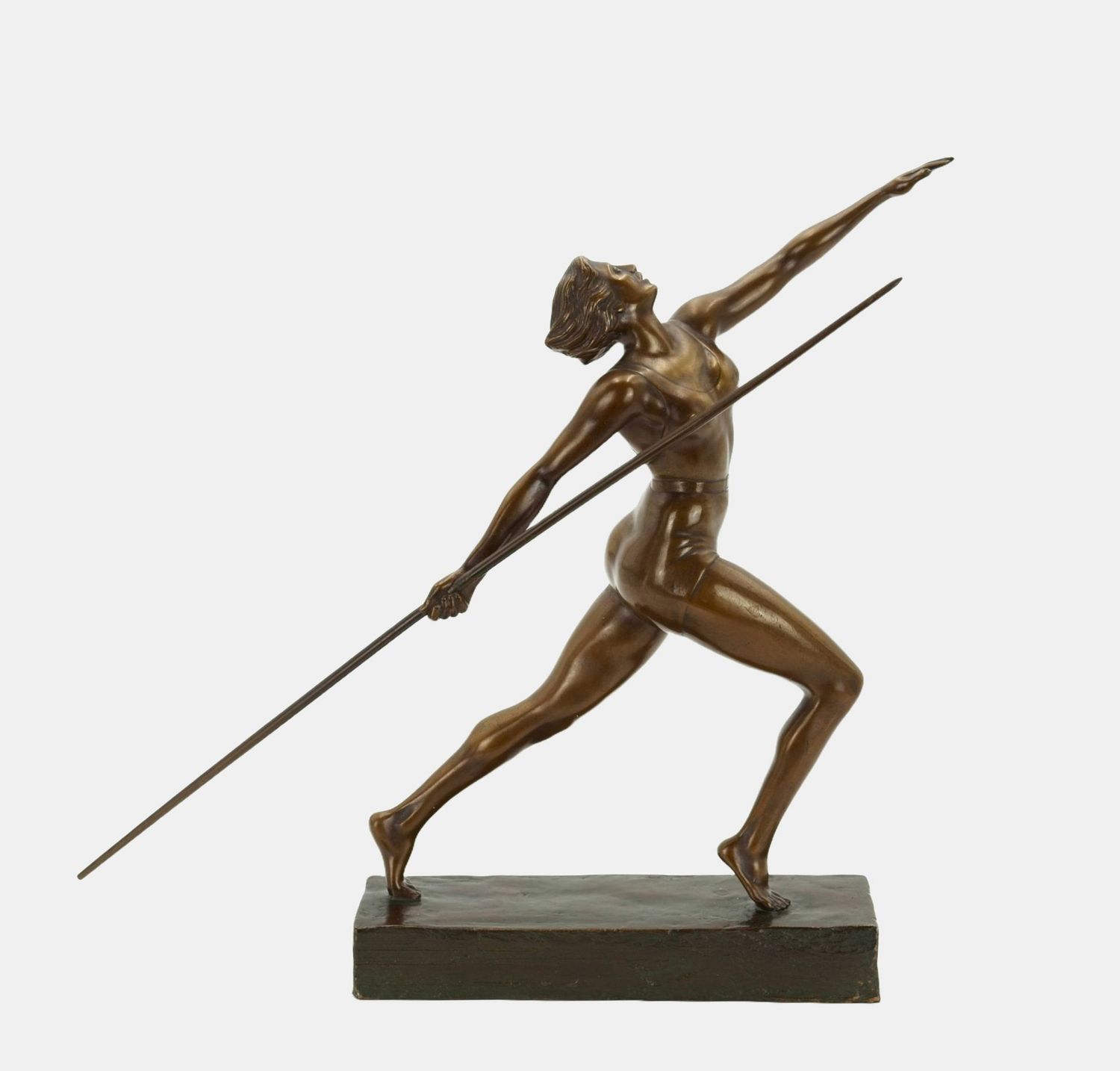Encke, Eberhard (1881-1936), Speerwerferin, 1932
Eberhard Encke(1881 Berlin - 1936 Bad Nauheim), Speerwerferin , 1932. Braun patinierte Bronze auf gegossenem rechteckigem Sockel. 30 cm (Gesamthöhe) x 32 cm (Länge mit Speer) x 8 cm (Tiefe), Gewicht 2,7 kg. Unter der Fußsohle mit „ENCKE“ signiert und auf „1932“ datiert, auf der Plinthe darunter mit der Gießereimarke „Lauchhammer Bildguss“ versehen.
- minimal berieben, insgesamt in einem altersgemäß ausgezeichneten Zustand
- Dynamische Schönheit -
Die Sportlerin hat den Anlauf zum Sprint gesteigert und wird im nächsten Moment den Speer himmelwärts werfen. Ihr linker Arm gibt die Flugrichtung vor, während der ausholende rechte Arm sicher den Speer führt. Die von der erreichten Geschwindigkeit zeugenden wehenden Haare, der vom schweren Atem geöffnete Mund und die leichte Torsionsbewegung des Oberkörpers künden den unmittelbar bevorstehenden Wurf an.
War die Schönheit im Anschluss an die antike Skulptur Ausdruck des in sich ruhenden, im Kontrapost dastehenden Körpers, was für die Berliner Bildhauerschule noch bis weit in die wilhelminische Zeit hinein maßgeblich war, so führte die Volkssportbewegung und die Wiedereröffnung der Olympischen Spiele 1896 zur Neuentdeckung der Schönheit des bewegten Körpers. Gerade in der vom Willen getragenen, zielgerichteten und äußerst konzentriert durchgeführten körperlichen Höchstleistung offenbart sich die kraftvolle Grazilität der Speerwerferin. Jeder Teil ihres vom Bewegungsimpuls durchdrungenen Körpers kündet von ihrer Schönheit, während das hauteng anliegende Trikot mehr enthüllt als verdeckt, was der Schönheit ein erotisches Moment verleiht.
Nehmen wir ihre Haltung in den Blick, bilden die weit ausgestreckten Arme eine Parallellinie zum Speer, die vom hinteren Bein wiederholt wird und sich in den wehenden Haaren wiederfindet. Das angewinkelte Bein formt zusammen mit dem Oberkörper eine die Parallelen ergänzende Zick-Zack-Form, so dass ein hochdynamisiertes körperliches Art Deco ‚Ornament‘ entsteht, welchen dem Bewegungsmoment eine überzeitliche Form verleiht. Damit schafft Encke ein herausragendes Werk der neuen Körperästhetik.
zum Künstler
Eberhard Encke war der Sohn des zur Rauchschule gehörenden Berliner Bildhauers Erdmann Encke (1843-1896), dessen 1880 im Tiergarten enthülltes Marmordenkmal der Königin Luise noch heute die Parkbesucher erfreut. Sein Sohn Eberhard studierte ab 1901 an der Münchner Kunstakademie zunächst bei Ludwig von Herterich und anschließend bei Wilhelm von Rümann. Nach dessen Tod setzte Encke das Studium an der Kunstakademie seiner Heimatstadt Berlin als Meisterschüler von Gerhard Janensch fort. 1906 debütierte er mit der Bronzestatute „Hermes“ auf der Großen Berliner Kunstausstellung und wurde im selben Jahr für seine lebensgroße Gipsfigur „Der Jüngling“ mit dem Rompreis der Akademie ausgezeichnet, was ihm einem Studienaufenthalt in Rom ermöglichte. Zurück in Berlin wurde er Meisterschüler von Louis Tuaillon, dessen „Amazone zu Pferde“ noch heute vor der Neuen Nationalgalerie und im Tiergarten wacht. In Tuaillons Atelier schuf Encke seine „Faustkämpfer“, für die er mit der „Goldenen Preußischen Staatsmedaille für Kunst“ ausgezeichnet wurde. Ein im zweiten Weltkrieg eingeschmolzener Bronzeabguss stand einst im Preußenpark in Berlin-Wilmersdorf, ein weiterer ist noch heute auf dem Rathausplatz in Hamburg-Harburg zu sehen.
Sein Vater hatte vor der Jahrhundertwende in Neubabelsberg den Erdmannshof erbauen lassen, den der Sohn ab 1907 an Peter Behrens verpachtete. Unter der Mitarbeit von Ludwig Mies van der Rohe, Walter Gropius und Le Corbusier realisierte Behrens 1911 das Mannesmanngebäude in Düsseldorf und 1912 das Continentalhaus in Hannover, für die Eberhard Encke die Bauplastik anfertigte. Das größte Projekt, bei dem Behrens und Encke zusammenarbeiteten, war die 1913 fertiggestellte Deutsche Botschaft in Petersburg, für die Encke eine monumentale Attikagruppe der Rosselenker schuf, die allerdings bereits kurz nach Beginn des Ersten Weltkrieges gestürzt wurde.
Ab 1911 betrieb Encke ein eigenes Atelier in Berlin-Friedenau bis er 1928 selbst in den Erdmannshof übersiedelte, wo er sich zunehmend der Schöpfung monumentaler Plastik widmete. Für die Olympischen Sommerspiele 1936 wurde er mit der temporären Monumentalskulptur auf dem Pariser Platz beauftragt, woraus die später in Bronze gegossenen, je zwei Männer und zwei Frauen darstellenden Gruppen „Streben nach olympischem Siegespreis“ entstanden. Noch im selben Jahr verstarb der Künstler bei einem Kuraufenthalt in Bad Nauheim.
Eberhard Enckes Oeuvre ist äußerst vielseitig und umfasst Salonskulpturen, Büsten, Grabplastiken, Denkmäler, Medaillen und Plaketten. Mit seinem Werk vermochte er es, die noch von seinem Vater zu wilhelminischer Zeit vertretende Rauchschule auf die moderne Skulptur hin zu öffnen.

